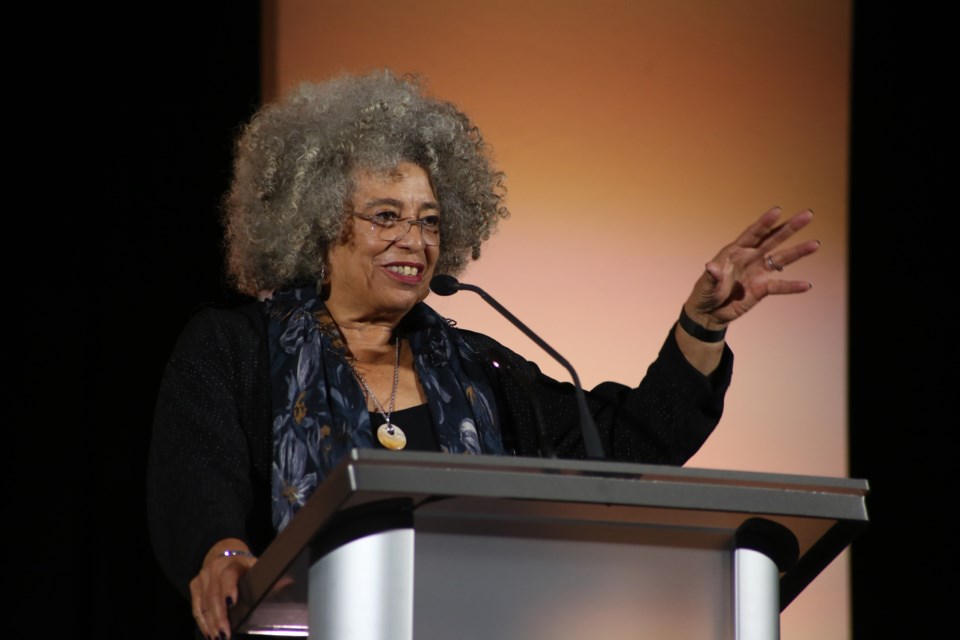After speaking for about an hour during a Black History Month event on Tuesday, activist and scholar Angela Davis was asked by a member of the audience how the youth of today can be heard.
“As black youth, how do we make a positive impact in the twenty-first century?” Asked the young woman in the audience. “How do I get my message out there?”
Davis, who grew up in Birmingham, Alabama during segregation and was an activist during the civil rights movement, threw the question back at the woman.
“Actually, that is a question I should ask you,” said Davis. “Change happens precisely because younger generations, armed with the knowledge that has been produced through the experiences of the older generations, are able to move in directions that cannot necessarily be predicted by those of us who are older.”
“My stance is one of learning from younger people, because those of us who have been around for a long time — our ideas may have been radical at one point and may have generated change, but they can also become stagnant,” said Davis. “You don’t want to repeat history over and over again. The way you get out of that vicious circle is by urging young people to take risks and use their imaginations and help to guide us to places we could not have even imagined.”
Davis is a professor emerita at the University of California Santa Cruz in Feminist Studies and History of Consciousness and is the author of numerous books. She lectures around the world and is a founding member of Critical Resistance, an organization dedicated to dismantling the prison industrial complex.
She is also known as a former member of the Black Panther Party and was once on the FBI's Most Wanted List.
Davis was speaking to an audience on Tuesday at the W.F. Mitchell Athletics Centre for a Black History Month-themed talk titled: Freedom is a Constant Struggle. The talk shares the name with one of Davis’ book, which was itself named after a song from the civil rights era.
Davis highlighted some of the song’s lyrics.
They say that freedom is a constant struggle
Oh Lord, we've struggled so long
We must be free, we must be free
They say that freedom is a constant dying
Oh Lord, we've died so long
We must be free, we must be free
“I like the irony of the last line of each of the verses,” said Davis. “There is simultaneously dejection and collective hope.”
Instead of defining freedom as a goal to be achieved one and for all, said Davis, the song invokes freedom as an ongoing process.
“Freedom indeed is a constant struggle. The song seems to contest the notion that freedom is simply a goal, a discernible state of being that we will certainly realize once we have achieved it,” she said.
Black history in the Americas has always been intertwined with the history of Indigenous people, Davis told the crowd of about 1,000 people at Tuesday’s talk.
“In North America, South America and the Caribbean, Indigenous people have always assisted enslaved Africans to escape their captors,” said Davis. “Black people today owe a profound debt of gratitude to the original inhabitants of this continent.”
She said the first slave rebellion in the Americas occurred in 1522, which makes the struggle for black freedom almost a 500-year-old fight.
“Let’s stop and think about that. That’s pretty remarkable, isn’t it? A freedom struggle that has unfolded over five centuries. One would assume that by now Black people would have given up — maybe some of them have,” said Davis. “Enough have continued the fight so that we can say that Black people have carried the baton of freedom and democracy and always managed to pass it on to the next generation.”
Notions of white superiority work against the frameworks of equality, justice and freedom, said Davis.
“It might be important to point out that the emergence of democracy in this part of the world was, in fact, a democracy of the minority. And what was described as justice and equality for all was actually only justice and equality for a few, because Indigenous people were excluded from the outset, black people were excluded — the vast majority of whom were slaves. Even white women were excluded and so that leaves us with white men, but not all white meant were included, it was affluent, property-owning white men. I think we are just beginning to realize we have been working with a sense of what constitutes humanity that is very narrow indeed.”
When Davis mentioned she had heard Viola Desmond was to appear on the Canadian 10 dollar bill, one was produced from the audience and she was able to look at it for the first time.
“I was reading that some of them don’t work in cash machines,” said Davis. “It’s like the existing structure doesn’t want to accept a black woman’s face on it — which makes me very happy.”
Racism is not only about individual attitudes, but that is often how conversations come to the public’s consciousness, said Davis.
“It seems that when racism is widely discussed, it has to do with unveiling individuals that are seen as deviant — whether because of the racist language they use or because of their proclivity to show up in blackface,” said Davis.
“I am not suggesting that blackface is not important,” she said. “But I want to raise questions about structural racism, about everyday racism.”
“It’s often assumed it’s a problem with the individual, so what you do is just take the individual out of his job, out of his position, or you send him to prison and then you forget about it and you don’t ask what has enabled this violence that is the most pandemic form of violence in the of the world,” said Davis.
